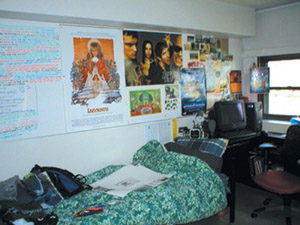 Editor's
Notes
Editor's
Notes
So many e-mails,
so many attachments
Chances are you’ve gotten an e-mail from someone
on a campus somewhere today. That’s not necessarily
good news.
As Frances (“Baby”) Houseman’s
father manfully told Johnny Castle in Dirty Dancing, just
before the movie and the summer ended and Baby went off
to begin her freshman year at Mount Holyoke, “When
I’m wrong, I say I’m wrong.”
 |
| Dorm.jpg: almost like
being there. |
What I’m wrong about this time
has to do with my own baby as she went off to college: my
expectation (recorded in this space last August) that she’d
no longer be a part of my daily life.
Can you say IM?
Now, thanks to Instant Messenger, e-mailed
attachments, and URLs, I not only heard from my daughter
most days last fall but also got images—her bulletin
board (Dorm.jpg), a Latin class toga party, and a closeup
of her school’s version of mystery meat, an item listed
on the cafeteria menu as “Dead Horse Ranch Red Chili
Enchiladas.” She even sent syllabi—her Intro
to Sociology course, I’m happy to report, featured
lots of Chicago names.
According to the January 6 New York
Times front-page story “Parents’ Role is
Narrowing Generation Gap on Campus,” I’m not
alone in my surprise at how often the kids write home. While
writing home, they’re also surfing, IMing buddies
across campus and country, and posting papers to course
discussion groups.
On the first Monday in December the U
of C received hard proof of just how much its denizens use
e-mail: what the campus Chronicle described as
“an unprecedented breakdown” of the University’s
Networking Services and Information Technologies (NSIT)
e-mail system, which processes 500,000 messages daily (of
12,000 active accounts, 3,000 are connected to the server
at any moment).
The culprit? A rare convergence of hardware
and software failures and overloads squared by the fact
that more and more users are sending out more, larger, and
more complicated messages. Adding to the problem, says the
University’s chief information officer, Greg Jackson,
many campus e-mailers still prefer the older, system-intensive
POP protocol rather than the newer IMAP protocol NSIT recommends.
After five days of 24–7 efforts—fueled
by regular pizza deliveries—NSIT had solved the immediate
problems. But the big-picture issue, Jackson explained,
is the tension between the need to adopt a new, unified
technology standard and the desire not to disturb the ingrained,
disparate habits of individual e-mail users at an institution
where an individual’s rights are taken very seriously.
Change, however, is in the air: “We’ve gotten
to the point where we simply cannot afford to run so complex
a mail system,” Jackson said, noting that everyone
now uses e-mail “in a way that could not have been
fully foreseen even as recently as three or four years ago.”
Archaeology’s
losses
“Deep into the Landscape”
discusses the pioneering work of Oriental Institute director
emeritus Robert Braidwood, PhD’43. As we went to press,
the Magazine learned of the January 15 deaths of
Braidwood and his wife and colleague, Linda Braidwood, AM’46.
Obituaries will appear in the April issue.
— Mary Ruth Yoe


![]() Contact
Contact
![]() About
the Magazine
About
the Magazine ![]() Alumni
Gateway
Alumni
Gateway ![]() Alumni
Directory
Alumni
Directory ![]() UChicago
UChicago![]() ©2003 The University
of Chicago® Magazine
©2003 The University
of Chicago® Magazine ![]() 5801 South Ellis Ave., Chicago, IL 60637
5801 South Ellis Ave., Chicago, IL 60637![]() fax: 773/702-0495
fax: 773/702-0495 ![]() uchicago-magazine@uchicago.edu
uchicago-magazine@uchicago.edu
